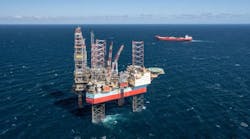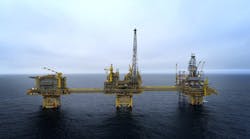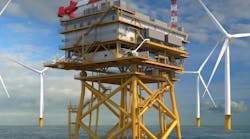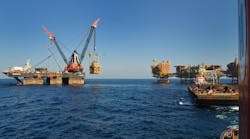By E. Harold Vickery
Leo E. Hill
Omar Y. Mohammed
Baker Oil Tools
Victor Forgenie
Carl H. Butler
BP
Roger McCollin
Hydrocarbon Outsource Ltd.
Helmy Fahmy
Gupco
Close cooperation between operator and service company played a major role in the first successful combination of two sand control completion techniques, extreme overbalanced (EOB) perforating and one-trip perforation gravel packing, in Egypt's offshore Ha'py Field.
Techniques reviewed
One-trip perforating and gravel pack completions were introduced in the mid-1980s to reduce completion times, associated rig costs, and the amount of fluid lost to the formation. Various designs have been used over the years with some success. As with other sand control methods, the approach has been used with typical underbalanced, balanced, and overbalanced tubing-conveyed perforating (TCP) techniques.
In many locations, one-trip methods have offered definite advantages over other cased-hole completion techniques in unconsolidated formations. Occasional problems associated with this technique have included completion equipment buckling and premature setting of the upper gravel pack packer following perforating. The root cause of these problems has often been the forces generated in the wellbore during perforating.
Extreme overbalanced perforating creates short fractures during or shortly after perforating and initiates near-wellbore fractures during perforating to help minimize the tortuosity effects of hydraulic fracturing. The technique also helps increase the number of perforations in communication with the wellbore for extremely long intervals. Since EOB was introduced in 1993, it has been applied in a variety of wells in both consolidated and unconsolidated formations, in some instances offering distinct advantages over other perforating techniques.
Prior to the completion of three wells in the Ha'py Field, one-trip perforating and gravel packing and extreme overbalanced perforating had never been applied concurrently.
Ha'py Field background
The Ha'py gas reservoir, discovered in 1996, is located in the Nile Delta, 45 km off the coast of Egypt in 75 m water depth. Between its discovery and the fall of 1997, three wells were drilled, cased, and temporarily abandoned in the A-20 reservoir.
The A-20 reservoir is at a depth of 1,430 m, at an initial reservoir pressure of 2,615 psi and a temperature of 74° C. The formation produced sand during the initial well tests of the discovery well, requiring sand control completions for long-term production from the field. Development plans for recompleting the three temporarily abandoned wells included drilling and open-hole completions.
Laser particle size analysis from core samples indicated poor sorting of the particles with D10/D95 ratios greater than 50% and sub 325 mesh percentages greater than 20%. To further complicate the completions, fluid testing of the core samples showed an extreme sensitivity of the formation to fluid salinity. A completion brine containing 10% methanol was selected based on core testing. Even with this fluid, a great deal of importance was placed on minimizing the amount of fluid that would be lost to the formation between the time the well was perforated and the time it was placed on production.
The core samples also showed a potential for fines movement. When this type of formation is encountered, it becomes very important to have as many perforations as possible contribute to well productivity to minimize the flow rate and pressure drop across each of the perforations. With the perforation intervals for these wells ranging from 64 m to 127 m, it was decided that normal underbalanced or overbalanced perforating could not provide the energy necessary to ensure that each perforation would contribute.
The development team decided to use EOB perforating to create near-wellbore fractures across each perforation and thus communicate the maximum number of perforations with the wellbore. EOB provides much more energy to the perforations during the TCP operation than does underbalanced perforating.
Considering the need to keep the fluid losses to a minimum, the appropriate types of completions were limited. Following several discussions between the operating company and the service company, a combination of EOB perforating and one-trip perforating and gravel packing was selected.
First well and observations
The first well completed in this project was in a payzone that had existing unsqueezed perforations. To perform an overbalanced perforation in this zone, it was necessary to isolate the tubing pressure from the existing perforations until the moment immediately after the guns had fired. The plan to accomplish this task was to run the downhole equipment into the wellbore with the tubing sealed to prevent wellbore fluid from entering.
It was thought that eliminating the perforated pup joint normally placed below the perforating packer would allow the fluid level to be controlled by the amount of fluid added from the surface while the equipment was being placed in the wellbore. Once the equipment was placed on depth and the packer was set, the extreme overbalance pressure would be applied at the surface with nitrogen. When the guns fired, the extreme overbalance pressure would be applied to the production zone through the tubing.
The plan to pressure the system with nitrogen without having a perforated sub was to run the assembly into the well without filling the tubing. The completion team, however, discovered that the perforating packer would not allow the equipment to be run with any significant differential across the packer.
Although the effect of the extreme pressures on the equipment was evaluated during the planning phase, the effects of differential pressure from not being balanced while running the equipment had been overlooked. The perforating packer that was selected for this work contains a two-piece mandrel and cannot be run into the well in an unbalanced condition.
Once the pressure difference between the tubing and annulus was greater than a few hundred psi, the packer would partially set. After that, the equipment could be moved uphole, but could not continue to go down.
For the system to work in a well containing existing perforations, the tubing would have to be allowed to fill with fluid as the equipment was being run. Subsequent to the equipment being placed on depth, the tubing would need to be displaced with nitrogen by placing a sliding sleeve below the perforating packer. The sleeve would be open while running the equipment and when the tubing was displaced with nitrogen. The packer could then be set, and the sleeve would be closed using wireline to isolate the tubing pressure from the annulus below the packer.
The major lesson learned concerned the energy actually expended during the extreme overbalanced perforating. Premature setting of the gravel pack packer was one of the major risks associated with the entire operation. Great care was taken to make sure that the hydraulic packer setting equipment during the operation did not see the overbalance pressure.
Special sleeves were developed and tested to completely isolate the setting equipment from the 7,000 to 8,000 psi of necessary pressure. A setting ball was dropped, and the pressure shifted the sleeve.
The equipment was placed on depth. Pressuring up the system with completion fluid fired the guns. After the guns fired and the system stabilized, the remainder of the procedure was followed without change and without problems. Total fluid lost to the formation during completion operations was 292 bbl.
Second well
The remainder of the wells to be completed in the project would have a perforated sub in the assembly above the firing head so the problem encountered with the perforating packer would not have any impact on the remaining completions. Also, there were no problems on the first well from the EOB pressures, so there were no changes made to the completion procedures before the second well was completed.
Initially, operations on the second well went as planned. The equipment was run into the wellbore, the completion fluid was displaced from the tubing to just above the gravel pack assembly with nitrogen, the perforating packer was set, and EOB perforating was achieved without incident. However, after the well was stabilized following perforating, it was discovered that the gravel pack packer had set prematurely.
Following this discovery, the service tools were released from the gravel assembly and removed from the well. The gravel pack assembly was retrieved without any significant problems, and the assembly was redressed and run back into the well. The well was gravel packed as a two-trip operation.
Total fluid lost to the formation during completion was 1,555 bbl, significantly more than that lost during completion of the first well. On investigation, it was discovered that the surge of fluid past the gravel pack packer setting tool during EOB perforating had shifted the isolation sleeve and exposed the setting port to the overbalance pressure, partially setting the gravel pack packer prematurely.
During EOB perforating with a nitrogen blanket above the gravel pack equipment, the formation is exposed to pressures exceeding formation fracture pressure. In this situation, once the fracture is initiated, the only real restriction to the temporary flow of fluid through the setting tool is friction. The energy generated by a high-pressure compressible gas as it expands forces the fluid below the gas into the reservoir at flow rates that can be extremely high.
Estimates of the temporary flow rate past the isolation sleeve were made. An estimate of the formation fracture extension pressure was used as the limiting pressure at the bottom of the workstring. The nitrogen pressure at the top of the liquid column inside the workstring was used as the other limit.
With these assumptions, a temporary flow rate was estimated to be as high as 36 bbl/min through the isolation sleeve. With the cross-sectional area of the sleeve, the friction from the flow of completion fluid past the sleeve at this rate provided sufficient force to shift the sleeve.
Third well
Before completing the third well, discussions were held on how to avoid the friction effects on the isolation sleeve. It was shown that the flow of nitrogen even at rates significantly higher than those experienced would not provide enough force to shift the isolation sleeve. Changed operational procedures for the third well completion included displacing the completion fluid to 100 ft below the packer-setting tool to avoid setting the packer.
Operations on the third well went as planned. The equipment was placed in the well, and the completion fluid was displaced to below the setting tool with nitrogen. The perforating packer was set, and the tubing pressured with nitrogen until the guns fired.
Completion fluid was displaced down the tubing and into the formation, and the well was stabilized. The perforating packer was released, the equipment moved across the perforations, and gravel placement was performed without problems. Total fluid lost during completion of this well was 508 bbl.
Lessons learned
Two significant lessons were learned about the EOB one-trip completion technique during these operations. First, the perforating packer used in the system cannot be run into the wellbore with any significant differential pressure. For this reason, if the zone to be completed must be isolated from the EOB pressures prior to perforating, then either some type of equipment must be placed above the perforating packer to provide for displacement of the completion fluid with nitrogen, or there should be a plan to displace the tubing with nitrogen using coiled tubing or by swabbing.
The second lesson is that the surge of fluids through the equipment during EOB operations can be very significant. In this system, the liquid column should be displaced below the isolation sleeve in the setting tool to avoid prematurely setting the gravel pack packer. If additional downhole equipment is used in the system other than those included here, the effect of this fluid surge past that equipment should be evaluated.
With the lessons learned during these completions, a much more robust system has been developed and implemented for one-trip perforate and gravel pack completions.
Summary
The newly combined method was used to successfully complete three high-rate gas wells. All three wells were completed on time and below cost estimates. Lessons learned from each completion were successfully transferred to subsequent operations. Total fluid losses to the reservoir during completion operations were minimal for the wells. All three wells are producing above initial estimated flow rates.
Acknowledgment
Much of the information in this article is taken from SPE 71671, "Extreme Overbalance Perforating and One-Trip Perforate and Gravel Pack-Combination of Two Techniques for Successful High Rate Gas Well Completions in the Ha'py Field," by E. Harold Vickery, Leo E. Hill, Victor Forgenie, Roger McCollin, and Helmy Fahmy. Carl H. Butler and Omar Y. Mohamed presented at the 2001 SPE Annual Technical Conference and Exhibition in New Orleans.







